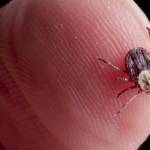Lyme Disease in Horses: Diagnosis and Treatment

Lyme disease can affect humans, dogs, cats, and possibly other animals. While many horses are seropositive (have antibodies in their blood) for Borrellia burgdorferi, the bacteria that cause Lyme disease, there is some question as to whether many horses actually develop an active infection with signs of the disease, or simply produce antibodies because of exposure to the bacteria.
Spread by the bites of affected ticks, Lyme disease can cause muscle pain and stiffness, mild lameness, and behavioral changes such as a dull or depressed attitude in affected animals. Weight loss, increased skin sensitivity to touch, and eye inflammation may also be seen. In horses, any of these signs may be related to other causes, making the diagnosis of Lyme disease challenging.
At the present time there is no specific equine vaccine to protect horses against Lyme disease, although a vaccine developed for dogs is sometimes used in equines.
Blood tests can determine antibody levels, but not all tests can differentiate between antibodies produced in response to vaccination or because of natural exposure, past infection, or current disease. For that reason, tests that reveal a high antibody level can’t prove that a horse does or does not have an active Lyme disease infection. The SNAP ELISA marketed for use in dogs is a fast and inexpensive way to check horses for antibodies without the cost and time required to send a blood sample to a laboratory; however, the test produces a moderate number of false negative results when used in horses.
With nonspecific disease signs and an uncertain diagnosis, what’s the best course of action if a horse is suspected of having Lyme disease? Veterinarians examining such a horse will initially try to rule out other diseases, and if no other cause is found for typical Lyme disease signs in a horse with a high antibody level, antibiotic treatment is usually begun. Intravenous tetracycline or oral doxycycline is commonly used but these treatments must continue for at least four weeks, sometimes multiple times each day, and the regimen is expensive and time-consuming. Even after four or more weeks of antibiotic administration, signs often persist or return.
Careful inspection for ticks during daily grooming is an important way to prevent Lyme disease, as infected ticks must be attached to a horse for at least 24 hours in order to spread the disease. By finding and removing ticks regularly, owners can greatly reduce the chance of infection. Ticks can be found anywhere on a horse’s body, but are most often seen on the lower legs and at the roots of mane and tail hairs.








